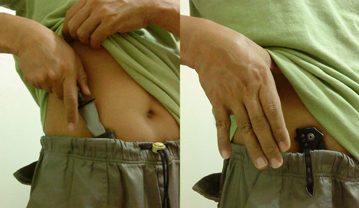Fast weapon deployment is a crucial area of study for practitioners of Filipino blade arts. Any individual who carries a knife for self-protection must be aware of the fact that his defense would almost always emanate from the draw. The weapon you’re carrying is only useful if you can deploy it fast enough against an attacker.
The knife, considered as the backbone of the Filipino martial arts (FMA), is still the easiest weapon to conceal. The type of knife you intend to carry will affect your method of concealment and the speed of its deployment. Fixed blade knives are faster to draw but are harder to conceal.
In comparison, folding knives, particularly the modern tactical folder offer ease of carry and concealment but are slower to deploy. The reason is because after you have drawn a folding knife, another action is required to open the blade and lock it in place.
The waist and the front pants pockets are the most preferable areas to conceal a knife if the goal is fast deployment because they are nearest to the hands. Where on these areas an individual would carry his blade is a matter of personal choice depending on the person handedness or laterality (is he left-handed or right-handed?).
There are basically two ways to retrieve a knife carried inside the waistband and under the shirt. In the case of a right-handed person, lift the shirt first with the left hand then draw the knife with the right hand (Photo A). The task can also be done with just one hand by using the thumb to lift the shirt before drawing the knife (Photo B). The advantage of the latter is that you still have one arm free to control or push an attacker while you are retrieving your blade.
A fixed blade knife is ready for action after the draw but not the folder. When carrying a tactical folder another important consideration is the position of the clip in relation to the blade – is the knife designed for tip-up or tip-down carry? You have to know because the orientation of the closed blade while in concealment will affect the speed of its deployment.
Make sure to opt for gross motor skills when drawing and opening a folding knife. This is a practical thing to do because when you are faced with a real threat, the first to diminish are your fine motor skills. I am personally wary of inertial openings that require you to pinch-grip the blade and flick the handle down via a snappy movement of the wrist to deploy a folding knife.
While it looks flashy during practice, there is a big chance that you could drop the knife if you use this method in a real fight. Pinch-gripping the blade is a fine motor skill task and is very difficult to do if sweat or blood has made the knife slippery.
The Tueller drill, popular among law enforcement officers could be integrated to knife training. Invented by an American police officer named Sgt. Dennis Tueller, this drill has repeatedly proven that an individual armed with a knife could, with relative ease, bridge a 21-foot gap and managed to stab an officer before he could deploy his handgun. The results of the tests conducted by Tueller were published by SWAT Magazine in 1983.
No matter how hard you train in drawing your knife, accept the fact that there are things that could get in the way of fast weapon deployment. There is a fat chance that you would always be dealing with a close-range threat in a real encounter. If your opponent succeeded in closing the gap before you can deploy your weapon, you’ve got to rely on empty hand skills to neutralize his onslaught and to reposition yourself so you can draw your knife.
If you’re training only in weapon skills to the exclusion of everything else then think again. The weapon, whether it’s a knife or a handgun, would not solve all tactical problems. Empty hand skills would often provide the crucial transition between your initial response to an attack and the actual deployment of your weapon.
The choice of grip is another area that involves personal preference. There are basically two ways of gripping the knife; the standard grip and the reverse grip (also known as the ice pick grip).
In the case of a fixed blade knife draw, the difference of movement dynamics between the standard grip and reverse grip would be evident right from the start. In the case of the tactical folder however, you have no choice but to grab it first in the standard grip to open and lock the blade in place before switching to reverse grip.
I personally prefer the standard grip over the reverse grip for two reasons. First is because it allows greater range of motion. The second and more important reason is that the standard grip gives you a longer reach.
You can test this by touching a wall with the tip of your knife, arm locked out using the standard grip. Then, without lowering your arm, transition to a reverse grip.
You will notice that by switching to the latter your reach was reduced by about one-and-a-half inch. A paltry difference if not for the fact that reach is everything in blade-to-blade fighting.





















